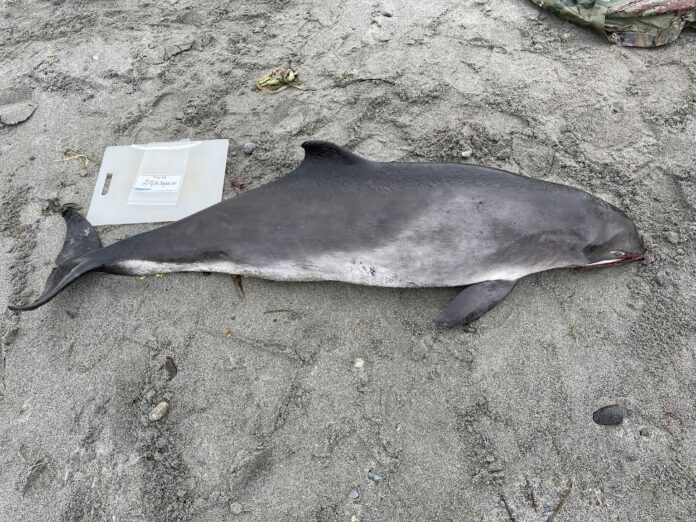A recent study led in part by the SeaDoc Society brought to light the link between marine, terrestrial and environmental health
By SONORA SLATER — science@theaggie.org
Cryptococcus gattii, or C. gattii, is a pathogen that causes a fungal disease that can infect dogs, cats, llamas, parrots, humans and more — and in hindsight, marine mammals might have been the ones to give us the first clue to the danger it posed.
In the early 2000s, this fungus infected hundreds of animals and people in British Columbia and Washington, and killed several dolphins and porpoises. On Oct. 22, a study that focused on C. gattii in marine mammals was published in the journal Diseases of Aquatic Organisms, led by a team of scientists from Canada and the Pacific Northwest, including those at the SeaDoc Society, a donor-funded program of the UC Davis Karen C. Drayer Wildlife Health Center.
According to a recent press release, the study explores “how human-caused changes on land can affect aquatic animals,” specifically in the case of C. gattii. The scientists assembled and then analyzed data that had been collected since the late 1990s by veterinarians, microbiologists, marine mammal biologists and marine mammal stranding responders, sequencing the history of the outbreak in marine mammals and investigating the implications.
Sarah Teman, a research assistant with the SeaDoc Society and the lead author of the paper, explained why although data on C. gattii has been collected for decades, the paper was just researched and written now.
“In order to characterize an outbreak, you need a lot of data,” Teman said. “We couldn’t just see this one case and say there’s an outbreak — so only over time after seeing these cases, especially in the early 2000s, were we able to say, okay, something did happen.”
According to Teman, the pathogen is typically found in tropical and subtropical forests, so when it was found in British Columbia and the Pacific Northwest, it triggered the SeaDoc Society and its collaborators to look at the data and study the disease.
- gattii live in soil and tree dwellings, and can cause disease when inhaled through environmental exposure. Teman described some previous studies investigating how human-caused activities may increase the risk of exposure for both people and animals.
“It’s likely that human-caused activities on land that can disrupt soil like construction or logging can actually aerosolize the fungus spores and cause them to be inhaled by people and animals, which is how the infection starts,” Teman said.
After the spores are aerosolized, they may settle on the sea surface, allowing them to be inhaled by marine mammals when they surface to breathe.
According to Teman, part of what supports this idea of how marine mammals became infected was that, using statistical methods, they found that animals who died from C. gattii were most likely to be found near terrestrial hotspots.
“Even though this disease originated on land, it was still able to spill over to marine mammals, which is quite concerning,” Teman said.
Steven Raverty, a veterinary pathologist for the British Columbia Ministry of Agriculture, Foods and Fisheries who worked on the study, described some of the possible explanations for how C. gattii may have appeared in British Columbia.
“One of the triggers might have been climate change — an increase in ambient temperatures,” Raverty said. “It could’ve been lying dormant in the soil, not causing any problems until a temperature threshold was crossed. An alternate hypothesis we’re thinking of is that the pathogen could’ve been carried across the ocean and deposited along coastal mountains with the rain.”
According to Teman, a veterinary pathologist identified the first probable case of C. gattii in a porpoise in the Pacific Northwest in 1997, two years before the identification of the first human case in the same region in 1999. Because of this, she believes that marine mammals can be “sentinels” for ecological health issues.
“[A] sentinel [is] an individual or a species that can alert us to potential issues or problems that are happening in the environment — it just shows us that marine mammals might alert us to problems that even we could face,” Teman said. “It’s not an isolated thing, just them or just us, it’s all so interconnected.”
“Studying marine mammals is good for the environment and good for people, and this ties into the greater One Health initiative that SeaDoc Society and UC Davis promote, which recognizes that the health of people, the environment [and] wildlife are all interconnected,” Teman said.
Brad Hanson, an ecologist at the Northwest Fisheries Science Center for the National Oceanic and Atmospheric Administration, expanded on this concept.
“Marine mammals are [an] important component of the marine ecosystems,” Hanson said via email. “Understanding their ecological role as well as their health is important to understanding and assessing ecosystem function and health, particularly for systems that [are] heavily urbanized like the Salish Sea. In this case there was a clear tie between the terrestrial and marine environments.”
Teman emphasized how much of the success of the study relied on its collaborative nature, which united 15 co-authors, 12 institutions and two countries.
“Science is so much better when you have so many different brains from different backgrounds and disciplines working on it,” Teman said. “Especially with UC Davis being such a multidisciplinary research powerhouse, and working with all of these amazing institutions, that’s what really made this project exceptional.”
Written by: Sonora Slater — science@theaggie.org




